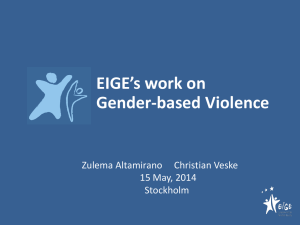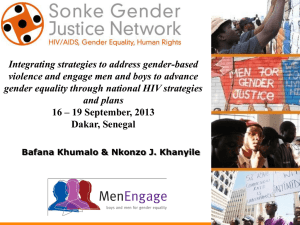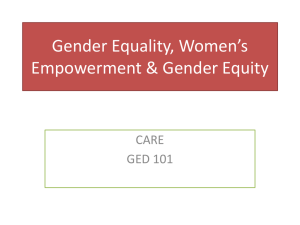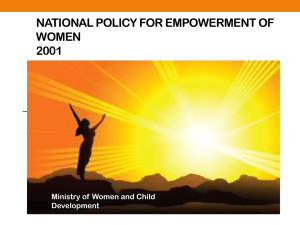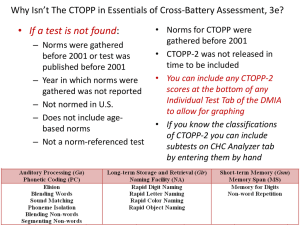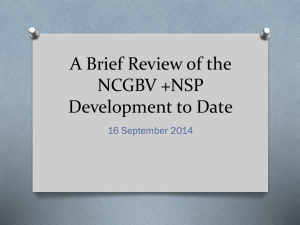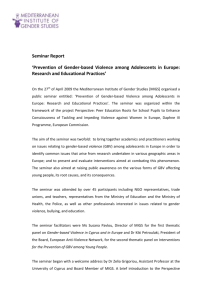Gender Transformative Norms Programming
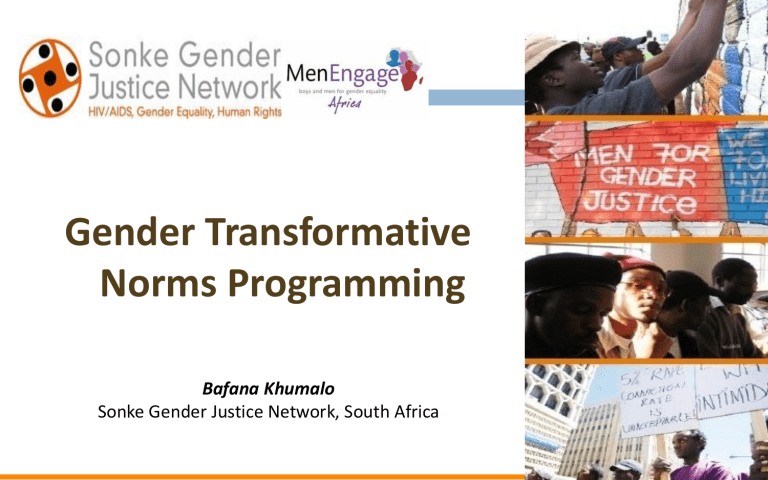
Gender Transformative
Norms Programming
Bafana Khumalo
Sonke Gender Justice Network, South Africa
Outline
Rationale and principles and rationale for the work
Overview of Sonke’s / MenEngage intervention strategy
Promising approaches
Strategies
Community Mobilisation
Policy Advocacy
Communication for behaviour change
Why work with men and boys?
Gender injustices and related concerns become more than just a ‘women’s issue’
Helps to address the causes and not just the consequences
Creates space to confront patriarchal notions of being male: the root cause of gender inequality and negative/risky masculinities.
Mobilises men as gender justice advocates: including policy makers and leaders
Makes HIV (and GBV) a societal, not just a women’s issue: creating an opportunity to address the behaviours that lead to violence.
Promotes behaviour change in men and boys through the identification and promotion of positive notions of masculinities
Shifts to a focus on prevention and changing attitudes and behaviour
There is an international mandate for engaging men and boys in achieving gender equality and h ealth equity.
It works
World Health Organization review of MI progs (2007).
A quarter successful in changing harmful gender attitudes and behaviour
Mentors in Violence Prevention (US),
small sample w/ comparison/control group, increased knowledge (correctly identifying sexual violence, GBV)
MAP in South Africa:
Changes in attitudes after participation
Soul City in South Africa:
exposure to TV shows led to more gender-equitable attitudes and increased communication related to GBV
Program H in Brazil/India:
Group education + community campaign led to increased condom use, lower STIs rates, attitude change
One Man Can (South Africa)
Workshop based training and awareness campaigns led to increased HIV testing, increased condom use and increased reporting of GBV
Guiding Principles
Recognize the gains made by the women’s rights movement
Promote women’s and girls’ rights
Work must be evidence based
See men as part of the solution, and not just the problem
Recognize relational nature of gender.
Be inclusive of and responsive to diversities among men
Address the underlying social and structural determinants of gender inequalities and injustice
Understand that the work is about sustainable BEHAVIOR change and requires long term commitments
“ True and lasting changes in gender norms will be achieved only when it is widely recognized that gender is relational, that it is short-sighted to seek to empower women without engaging men, and that it is difficult if not impossible to change what manhood means without engaging
...women.”
(Gary Barker)
Engaging Men
Points of engagement best seen as a continuum
As partners:
Allies who support women and girl empowerment initiatives
As clients :
Targets and recipients of state services such as health, educationand psycho-social support
As agents of change:
Activists who work for gender equality and equity
Gender challenges in the region
•
•
•
•
•
•
•
Early marriages,
Virginity testing
“ukuthwala” / Bride kidnapping
GBV
Wife inheritance,
Hate crimes related to the LGBTI sector
Forced arranged marriage, etc…
Gender Integration
Refers to strategies applied in program assessment, design, implementation, and evaluation to take gender norms into account and to compensate for gender inequalities.
Gender Integration Continuum
A way of measuring how successful we are in integrating gender into our programs
Gender Integration Continuum
Gender synchronized
Percentage of women who think violence against them is acceptable and sometimes justified
Advances for Women in the Past 20 Years
Greater parity in education
Women’s economic empowerment
Women’s political advancement
Improvements in legislation in support of women’s rights
Limits to those advances have something to do with patriarchal tendencies
Limits of educational parity
– dangerous schools, sexual violence,
Women’s economic empowerment
Political improvements – tokenism, failure to implement
Gender-Transformative Programs with Women
• Change the gendered power dynamics between men and women
• Provide access to education and skills
• Provide access to economic resources and assets
• Build social capital and support
Gender-Transformative Programs with Men
• Allow men to come together and discuss masculinity
• Examine the costs of negative masculinities
• Engage men in social action to challenge existing gender norms
• Encourages men to focus on being allies to women & the agenda for change
What is Missing from These
Single-Sex Approaches
?
•
The broader awareness of how gender norms are reinforced by everyone in the community.
•
Recognition that true social change has to come from work with both sexes – with everyone.
Defining Gender-Synchronized
Programs
•
The intentional intersection of gender transformative work with men and with women
•
Engage both sexes in challenging harmful constructions of masculinity and femininity
•
Equalize the balance of power between men and women in order to ensure gender equality and transform social norms that lead to gender-related vulnerabilities
•
View all actors in society in relation to each other
•
Identify and create shared values that promote human rights , nonviolence, equality and gender justice
Some Paradigms for Gender Work
•
•
•
•
Women’s Empowerment enhances the status of women, increasing women’s power and access to resources relative to men
Constructive Men’s Engagement (CME) promotes gender equity, increases men’s support for women’s SRH and children’s well being, and advances the health of men, women, and children.
Gender Transformative Approaches questioning, and changing inequitable gender norms and imbalance of power as a means of reaching gender equity objectives.
Gender Synchronized Approaches intentional intersections of gendertransformative efforts reaching both men and boys and women and girls.



